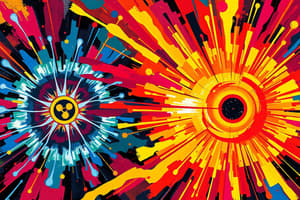Podcast
Questions and Answers
What state of matter is formed when the temperature reaches almost 15 million °C?
What state of matter is formed when the temperature reaches almost 15 million °C?
- Liquid
- Solid
- Plasma (correct)
- Gas
During the fusion process, what happens to one of the protons?
During the fusion process, what happens to one of the protons?
- It is converted into a positron.
- It turns into energy directly.
- It changes into a neutron. (correct)
- It splits into electrons.
What is the nature of the particles released during the fusion of protons?
What is the nature of the particles released during the fusion of protons?
- A neutron and an electron.
- A photon and a proton.
- A positron and a neutrino. (correct)
- Two electrons and a proton.
What forms the nucleus of the isotope of hydrogen known as deuterium?
What forms the nucleus of the isotope of hydrogen known as deuterium?
What is the overall result of the fusion reactions involving hydrogen?
What is the overall result of the fusion reactions involving hydrogen?
Flashcards are hidden until you start studying
Study Notes
Fusion
- Fusion requires extremely high temperatures, around 15 million °C.
- At these temperatures, electrons become unbound from protons, forming plasma.
- Plasma consists of positively charged ions and free electrons.
- Despite proton repulsion, gravity forces them together, leading to fusion.
- During fusion, a proton transforms into a neutron, releasing a positron and a neutrino.
- Positrons are positively charged antiparticles of electrons.
- Positrons annihilate with electrons, producing high-energy gamma rays.
- Fusion forms a deuterium nucleus, an isotope of hydrogen.
- Further fusion reactions convert hydrogen into helium, neutrinos, and energy.
Studying That Suits You
Use AI to generate personalized quizzes and flashcards to suit your learning preferences.




